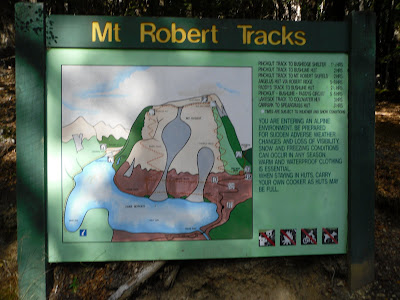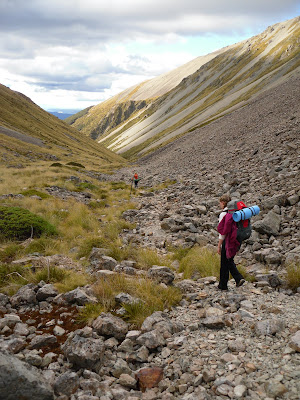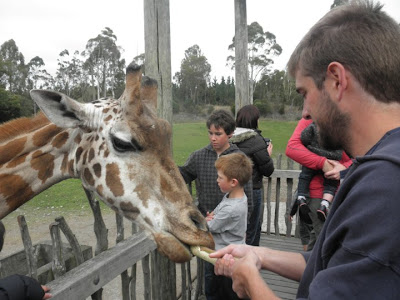Oh, my muse, where art thou? Hast thou forsaken me? Turned your back on me? Where is the motivation? The heart? The soul?
Alas, I shall attempt to move forward, alone.
Following a day of carousing with large cats, a change of scenery was in order. It was essential to utilize the April break in the best possible way, and staying in Christchurch was far from this. The west had been conquered with the trip to Fox Glacier. The immediate Canterbury area exhausted with trips to Kaikoura and Hanmer Springs. The south would come. For now, it was time to turn towards the north.
Nelson Lakes National Park, located roughly 350 kilometers from Christchurch, was easily identified as a desirable destination. Featuring twin lakes, Rotoiti and Rotoroa, the park contains enough hiking tracks to keep one occupied for months. As the plan was to spend only the weekend, we realized that there would be no issue in filling the time.
The real challenge would be to avoid becoming overwhelmed at the sheer size of the park or the volume of activities it offered. But with the failure of Arthur's Pass still fresh in the mind, a successful tramping trip was understood as the only path to redemption. And given that the weekend's weather forecast called for warmth and sun, there was little chance of another rainout. Or so the hope went.
Leaving late in the afternoon on April 6, the park itself was not reached until dusk was already closing in. Racing up to a scenic outlook, the scope of Nelson Lakes began to unfold.

Really, this picture does no justice. I am tempted to remove it entirely, as it disgusts me to even glance at it.
Trees and forest stretched as far as the eye could see, in every direction. The lake sprawled out in front of us hundreds of meters below, disguising its enormity. With the sun reflecting off of its surface and touching nothing but the dense and green vegetation, the water shimmered as blue as any lake ever having eyes laid upon. Engulfing the scene in its entirety were mountains, towering above it and separating the other similarly massive regions of the park that lay just beyond.
So, yes, I am appalled by this photograph and hope that you will not judge its true beauty by a single image alone. If there is justice in this world, it does not exist within this picture.
Turning back towards the hill we had persuaded the Blue Bandit to climb, we creaked our way back down to a campground for the night, excited to produce a clearer picture of Nelson Lakes on the following day.
And as we awoke early and stumbled down to the edge of the lake featured in the above horror show, such visual stimulation was located.

The clouds lingered, seemingly only a few short feet above the water, obstructing the view of the mountains hiding behind. The lake - and an enormous lake it was - was as still as a piece of glass, reflecting on its surface the view found above the horizon.

For a long time we sat on this dock and did very little. The sun. The clouds. The mountains. The slow movement of feet dangling over the edge. The startling cold of the water. The few ducks that glided towards us as we basked in the heat and tranquility, begging with nothing more than their proximity. I will remember this scene vividly as I grow older.
Finally turning away from the lake, we hurried to chart a suitable course of action. With the help of a nearby Department of Conservation center (enjoying the outdoors in New Zealand would be far more difficult if not for these sites), it was determined that the best route to take led up a steep and winding path to the peak of Mt. Robert, along the lengthy ridge towards Mt. Angelus, then a rapid descent into a valley running along a stream.
The map purchased at the DOC center helped to determine this; the map below (found at the base of the track) did not.

Beginning the trek up Mt. Robert, the track was steep and filled with switchbacks. By far the most difficult part of the two-day hike. Rising quickly towards the edge of the treeline, the lake again began to fall away from us. Switchback after switchback, marching upwards to the peak. As the clouds gained elevation in the midday sun, so did we.

After climbing in silence for the better part of an hour, the top of Mt. Robert had been reached. Though not as spectacular as some of the other peaks conquered throughout New Zealand, seeing the lake as little more than a speck was satisfying, a clear indication of the distance we had traveled.
Turning towards the ridge, we began to move. It was to be about a four hour walk along the ridge, and after that the distance needed to be covered before dark was unclear. Our pace was not slow.

Though never one to look back, these next few shots are of the ground we had already covered on the ridge. It's not where you've been, but where you're going... unless it looks like this.



Though the ride was rather evident and well-traversed, do not make the mistake of thinking that it was a casual stroll through some rolling hills.

Rather, the road was rugged, with rocks and boulders strewn about, jabbing into the soles of the feet as the weight of your pack was multiplied by the constant jarring that resulted from bounding from rock to rock.
But that is really nothing. To be expected, really. As were the changes in elevation that took place along the path across the ridge. Rising and falling from about 1450 meters to 1900 meters, it was a seesaw-like trek covering multiple kilometers.
The view was impressive. The view was tremendous. Inspiring. Other adjectives.
With green valleys running into distant mountains and the occasional lake or stream on each side, a real sense of isolation was present. Isolation in the form of a complete detachment from society of any kind. There was the ridge, there were the mountains, there were the lakes, and there was us. Every so often a rival hiker would shatter the illusion of complete solitude by rudely intruding upon our quest (can a "hello!" or a "nice day, no?" be any more sickening?), but these were minor annoyances in the more grand affair.



Briefly halting for lunch after traversing a particularly treacherous area of large and loose rocks, we were better able to appreciate our surroundings, given the accelerated pace we had been moving at.
Those rock formations were like something off of a postcard, though the same can be said for much of New Zealand, or at least I imagine. From a seated position and enjoying a sandwich, it was much easier to gawk at these surrounding boulders. Having nearly lost my balance and tumbled down the side of a cliff while climbing over them, I had not previously been in the ideal position to admire such structures.

The view from the rocks on which we dined.

Though generally not one for subscribing to any higher spiritual order, sights such as these resonate deeply within. Powerful beyond words. I'm sure others can think of times when nature has taken their breath away, left them speechless, yet also as grateful as one can be. New Zealand does not leave you speechless. It tears on your tongue.
We moved quickly after lunch, pushing forwards on the ridge as it moved out and began to swing back towards the northeast. Crossing through four basins on our immediate left, eventually a hairpin right would have to be taken, cutting directly down from the ridge towards a creek running south. The basins were separating by the mountain ranges jutting perpendicular to Robert Ridge, creating several valley filled coated in green and featuring multiple ponds.


Finally discovering the point at which the move southward was to occur, we stood at roughly 1800 meters. The creek we were to follow sat at just over 1100 meters. Elevation would have to be dropped, and quickly.
The view to the left led down into another valley, though its walls were composed mostly of rock, lacking the widespread color of previous basins.

To the right, facing south, was the route that would lead to that refuge for the evening, and eventually to civilization on the following day. With the mountains not as tightly packed as the ranges facing north, there was a clear line of sight extending out into the park. Mountains, smaller hills, large patches of vegetation, and bodies of water were all the could be seen, shimmering in the late afternoon sun.

As we stood admiring the new view presented by our change in direction, we received a reminder of the extent to which we stood above the sea. Dragging supplies to a nearby hut that was being rebuilt, the shape of a helicopter suddenly appeared over a neighboring peak. The machine, being surprisingly low to clear the ridge, was frighteningly loud as it roared past.

The drop down to the creek was to be a sudden and rather dramatic one. And, really, it had to be, as dropping 700+ meters in a kilometer or so doesn't happen through a gradual descent.
Reminiscent of the perils faced on the trip to Avalanche Peak, the track down wasn't much of a track at all. Rather, it was a steep wall of loose rocks, some bordering on the label of boulder. Some group members were skeptical, yet all moved forward.

Steep. But rather quick-moving. The skills employed at the aforementioned Avalanche Peak were put to good use, utilizing the similar method of gliding down on top of the loose rock, ice-skating down the side of a cliff, in a way. Or cross-country skiing; I'm not sure. Feet constantly churning, never allowing themselves to be buried in the large stones that chased after us, it was more sprint than delicate descent. So yes, rather quick-moving.
Once at the base of the stream, it was time to trek into the heart of this particular valley, now running south on the Speargrass Track.
And so it went from there. The route was relatively similar from this point on, following the creek as we slowly weaved our way back below the treeline. The sun had quickly sank behind the looming walls of the valley, and we marched in relative silence along the water, occasionally stopping to refill a water bottle (crisp and pure water; how I love thee!) or to leap across embankments towards the opposite side.

Stopping for the night just before dark, we spent the night in a D.O.C. hut around a warm fire, drying out of damp socks and avoiding the cold wind that tends to whip through the cloudless autumn nights in New Zealand.
The next day was vastly different from the previous. Replacing the climbing and falling ridges and stunning peaks was the dense and dark forest, blocking the light as much as the light rain that fell early in the morning.


Continuing to follow the creek, it was a few short hours before we arrived back at the base of the track, bursting out of the forest into the sunshine that had now overtaken the park. Dropping the packs to the ground, we collapsed on a bench on the grass, admiring the same view that was so poorly captured at the beginning of this story.
At this moment, however, the scene was even more glorious than before, if such a thing is possible. Another sliver of an amazing country had been thoroughly explored, and even more thoroughly more enjoyed.
Much like the dock, we sat on the bench and did not speak. The sun warmed our skin and dried the sweat that soaked our clothing. A bee buzzed harmlessly near our ears. A gentle breeze rustled through the ever-changing foliage. I took a deep breath, paused, then stood and turned for the car.













